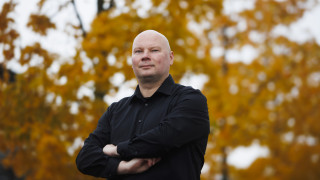3.3.2023 Nuclear spectroscopy: The shapes of Pb-186 under investigation (Ojala)

The atomic nucleus is a quantum mechanical object which involves many phenomena that are difficult to understand with common sense. One of these phenomena is the coexistence of shapes, where the same nucleus can have several different shapes, such as spherical, prolate (cigar-shaped) or oblate (disc-shaped). These phenomena have been observed in neutron-deficient lead cores.
An earlier alpha-decay experiment has also shown the phenomenon's existence with lead-186. In the dissertation research, it was possible to determine the lowest excited 0+ state for lead-186 in a structure assumed to be prolate. The results provide essential additional information for new theoretical calculations.
"These results help us to understand the operating principles of atomic nuclei, the modelling of which is a complex task. Fortunately, as an experimenter, I only make observations about nature."
The measurement discussed in the dissertation was carried out using the SAGE detector system in 2013. In his dissertation research, Ojala analysed the data obtained from this experiment, interpreted the results, and published the results as part of a larger international research collaboration as the first author in Nature Communication Physics.
During his doctoral studies, Ojala also participated in developing a gamma spectrometer at the Accelerator Laboratory of the University of Jyväskylä, where a movable germanium detector spectrometer, JUROGAM3, was installed. Germanium detectors are used to detect gamma radiation, which is produced when the nucleus de-excites. The observed gamma rays can be used to interpret the structure of the nucleus.
In addition to dissertation research, Ojala has been involved in installing various detector systems at Jyväskylä Accelerator Laboratory and in CERN at ISOLDE. In 2017-2018, Ojala participated in the installation of the SPEDE detector in the IDS test setup at ISOLDE. Ojala also participated in the installation of the SAGE spectrometer in conjunction with the MARA separator during his doctoral studies. In the spring of 2021, the tests carried out with this SAGE were successful and proved the functionality of the SAGE with the MARA separator. Ojala was one of the spokespersons for one of these experiments.
Ojala graduated from Seinäjoki high school in 2011 and a master's degree in 2017. In 2016, he did an internship at CERN. Since 2017, he has worked as a doctoral researcher in the nuclear spectroscopy group of the Accelerator Laboratory of the University of Jyväskylä. Today, Ojala works as a researcher at the University of Liverpool, where his research focuses on experiments at the ISS and MINIBALL test stations at ISOLDE.
M.Sc. Joonas Ojala defends his doctoral dissertation ”Combined γ-ray and electron spectroscopy: study of shape coexistence in 186Pb” on 3 March 2023 at 12 noon. The opponent is Senior Lecturer, Dr. Daniel Doherty (University of Surrey, UK) and custos is Senior Researcher Janne Pakarinen (University of Jyväskylä). The language of the dissertation is English.



